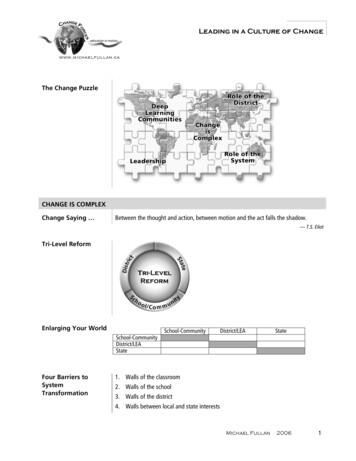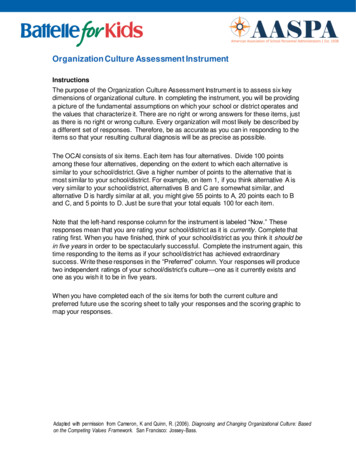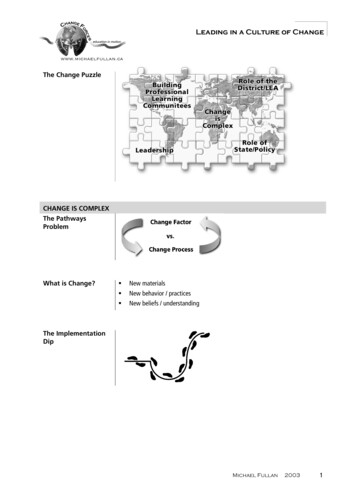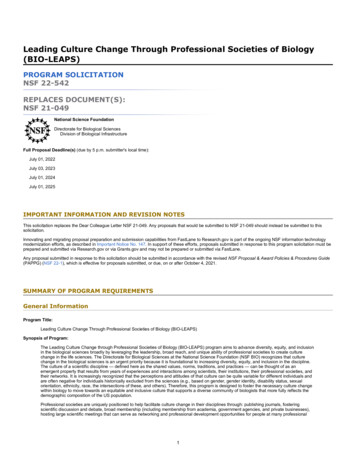
Transcription
Leading in a Culture of Changewww.michaelfullan.caThe Change PuzzleCHANGE IS COMPLEXChange Saying Between the thought and action, between motion and the act falls the shadow.— T.S. EliotTri-Level ReformEnlarging Your nityDistrict/LEAStateFour Barriers toSystemTransformation1. Walls of the classroom2. Walls of the school3. Walls of the district4. Walls between local and state interestsMichael Fullan20061
Leading in a Culture of ChangeS-t-r-e-t-c-h YourThinkingCooperativelyTASK: Together: Why does education reform often fail?1. List 10 or more underlying reasons for the problem.2. Of all the reasons listed, which one is most at the "heart" of the problem?3. All teammates must be prepared to present and defend the team answer.Time: 10 minutes.WorksheetTeam Answer Sheet1.2.3.4.5.6.7.8.9.10.Point & Go Fireside Chat2 One person from each team takes his/her team’s idea that is most at the “heart”of the problem to another team. Discuss rationale for reasons selected.Large group debrief.Meet up with one other person in the room who is not at your table and discusswhat your learning goals are for the day. What would you like to get out oftoday?www.michaelfullan.ca
Leading in a Culture of ChangeThe PathwaysProblemWhat is Change? New materials New behaviour/practices New beliefs/understandingThe ImplementationDipInertiaInertial forces favour the status quo.Michael Fullan3
Leading in a Culture of ChangeBrain BarriersBB #1: Failure to seeBB #2: Failure to moveBB #3: Failure to finish— Black & Gregersen, 2002BB #1: Failure to See The comprehensiveness mistake The ‘I get it’ mistake Illuminate the right thing— Black & Gregersen, 2002BB #2: Failure to Move The clearer the new vision the more immobilized people become! Why?— Black & Gregersen, 2002Right Thing PoorlyThe clearer the new vision, the easier it is for people to see all the specific ways inwhich they will be incompetent and look stupid. Many prefer to be competent at theold wrong thing than incompetent at the new right thing.— Black & Gregersen, 2002BB #3: Failure toFinishPeople get tired.People get lost.— Black & Gregersen, 2002Breaking ThroughBarriers Conceive Believe Achieve— Black & Gregersen, 2002Technical vs AdaptiveChallengeHeifetz distinguishes between technical problems and adaptive challenges. Technicalproblems are ones for which our current know-how is sufficient. Adaptive challengesare more complex and go beyond what we know. Heifetz identifies several propertiesof adaptive challenges:1. The challenge consists of a gap between aspiration and reality demanding aresponse outside our current repertoire.2. Adaptive work to narrow the gap requires difficult learning.3. The people with the problem are the problem, and they are the solution.4. Adaptive work generates disequilibrium and avoidance.5. Adaptive work takes time.— Heifetz & Linsky, 20044www.michaelfullan.ca
Leading in a Culture of ChangeRepetitive ChangeSyndrome Initiative overload Change-related chaos Employee cynicism— Abrahamson, 2004Change Without PainCreative destruction(destroys, removes)vsCreative re-combination(recombines and adds to existing assets)— Abrahamson, 2004Freewrite:What is your key learning from this module?How can you maximize action or doing?Worksheet — FreewriteMichael Fullan5
Leading in a Culture of ChangeFollow-Up Reading10 Do and Don’t Assumptions About ChangeFullan, 2001b, pp. 108-1101. Do not assume that your version of what the change should be is the one that should or could be implemented.On the contrary, assume that one of the main purposes of the process of implementation is to exchange yourreality of what should be through interaction with implementers and others concerned. Stated another way,assume that successful implementation consists of some transformation or continual development of initialideas.2. Assume that any significant innovation, if it is to result in change, requires individual implementers to work outtheir own meaning. Significant change involves a certain amount of ambiguity, ambivalence, and uncertainty forthe individual about the meaning of the change. Thus, effective implementation is a process of clarification. It isalso important not to spend too much time in the early stages on needs assessment, program development, andproblem definition activities — school staff have limited time. Clarification is likely to come in large partthrough reflective practice.3. Assume that conflict and disagreement are not only inevitable but fundamental to successful change. Since anygroup of people possess multiple realities, any collective change attempt will necessarily involve conflict.Assumptions 2 and 3 combine to suggest that all successful efforts of significance, no matter how well planned,will experience an implementation dip in the early stages. Smooth implementation is often a sign that not muchis really changing.4. Assume that people need pressure to change (even in directions that they desire), but it will be effective onlyunder conditions that allow them to react, to form their own position, to interact with other implementers, toobtain technical assistance, etc. It is alright and helpful to express what you value in the form of standards ofpractice and expectations of accountability, but only if coupled with capacity building and problem-solvingopportunities.5. Assume that effective change takes time. It is a process of “development in use.” Unrealistic or undefined timelines fail to recognize that implementation occurs developmentally. Significant change in the form ofimplementing specific innovations can be expected to take a minimum of two or three years; bringing aboutinstitutional reforms can take five or ten years. At the same time, work on changing the infrastructure (policies,incentives, capacity of agencies at all levels) so that valued gains can be sustained and built upon).6www.michaelfullan.ca
Leading in a Culture of Change6. Do not assume that the reason for lack of implementation is outright rejection of the values embodied in thechange, or hard-core resistance to all change. Assume that there are a number of possible reasons: valuerejection, inadequate resources to support implementation, insufficient time elapsed, and the possibility thatresisters have some good points to make.7. Do not expect all or even most people or groups to change. Progress occurs when we take steps (e.g., byfollowing the assumptions listed here) that increase the number of people affected. Our reach should exceedour grasp, but not by such a margin that we fall flat on our face. Instead of being discouraged by all thatremains to be done, be encouraged by what has been accomplished by way of improvement resulting fromyour actions.8. Assume that you will need a plan that is based on the above assumptions and that addresses the factorsknown to affect implementation. Evolutionary planning and problem-coping models based on knowledge ofthe change process are essential.9. Assume that no amount of knowledge will ever make it totally clear what action should be taken. Actiondecisions are a combination of valid knowledge, political considerations, on-the-spot decisions, and intuition.Better knowledge of the change process will improve the mix of resources on which we draw, but it will neverand should never represent the sole basis for decision.10. Assume that changing the culture of institutions is the real agenda, not implementing single innovations. Putanother way, when implementing particular innovations, we should always pay attention to whether eachinstitution and the relationships among institutions and individuals is developing or not.Michael Fullan7
Leading in a Culture of ChangeLEADING IN A CULTURE OF CHANGEThe Change PuzzleFramework forLeadership— Fullan, 2001aCollins’ Hierarchy ofLeadershipLevel 5 Executive(builds enduring greatness)Level 4 Effective Leader(catalyses commitment to vision and standards)Level 3 Competent Manager(organizes people toward objective)Level 2 Contributing Team Member(individual contribution to group objectives)Level 1 Highly Capable Individual(makes productive contributions)— Collins, 20018www.michaelfullan.ca
Leading in a Culture of ChangeCollins’ Flywheel— Collins, 2001Good to Great andthe Social SectorsWe must reject the idea — well intentioned, but dead wrong — that the primarypath to greatness in the social sectors is to become “more like a business.”The confusion between inputs and outputs stems from one of the primary differencesbetween business and the social sectors. In business, money is both an input (aresource) and an output (a measure of achievement). In the social sectors money isonly an input — performance must be assessed relative to mission, not financialreturns [define great performance relative to your mission].In business, Collins said the Hedgehog Concept combined “passion”, “being best atwhat you do”, and the “economic engine.” In the social sector he says the thirdfactor is “the resource engine” (time, money, brand, energy).By focusing on your Hedgehog Concept you build results. Those results, in turn,attract resources and commitment, which in turn bring more results and moreresources, and so on — the flywheel spins faster and faster.The key question is not business versus social but great versus good. Greatness islargely a matter of conscious choice, and discipline.— Collins, 2006Flywheel in theSocial SectorsAttract Believers Build Strength Demonstrate Results Build Brand(emotion, reputation)— Collins, 2006Charismatic Leadership is negatively associated with sustainability.Sustaining Leaders have deep personal humility and intense professional will.Michael Fullan9
Leading in a Culture of Change Think of a situation where you encountered strong resistance. What actions did you take initially? Using the worksheet below, pair up and interview your partner.WorksheetDealing with ResistanceThe SituationPerson 1Person 210www.michaelfullan.caInitial Action/Reaction
Leading in a Culture of ChangeMaking MattersWorse“When we face resistance to our ideas, most of us react with an assortment ofineffective approaches. These are our default positions.” Use power Play off relationships Manipulate those who oppose Make deals Apply force of reason Kill the messenger Ignore resistance Give in too soon— Mauer, 1996Why DefaultStrategies Don’tWork and may often escalate and strengthen opposition to your goals They increase resistance The win might not be worth the cost They fail to create synergy They create fear and suspicion They separate us from others— Mauer, 1996Getting Beyond theWallFive Fundamental Touchstones1. Maintain clear focus Keep both long and short view Persevere2. Embrace resistance Counterintuitive response Understand voice of resistance3. Respect those who resist Listen with interest Tell the truth4. Relax Stay calm and stay engaged Know their intentions5. Join with the resistance Begin together Change the game Find themes and possibilitiesConsider strategies that incorporate most (or all) of the touchstones!— Mauer, 1996Michael Fullan11
Leading in a Culture of ChangeEmotional IntelligenceGoleman et al., 2002, Appendix B, pp. 253-255Self AwarenessEmotional self-awareness. Leaders high in emotional self-awareness are attuned to their inner signals, recognizinghow their feelings affect them and their job performance. They are attuned to their guiding values and can oftenintuit the best course of action, seeing the big picture in a complex situation. Emotionally self-aware leaders can becandid and authentic, able to speak openly about their emotions or with conviction about their guiding vision.Accurate self-assessment. Leaders with high self-awareness typically know their limitations and strengths, andexhibit a sense of humour about themselves. They exhibit a gracefulness in learning where they need to improve,and welcome constructive criticism and feedback. Accurate self-assessment lets a leader know when to ask for helpand where to focus in cultivating new leadership strengths.Self-confidence. Knowing their abilities with accuracy allows leaders to play to their strengths. Self-confidentleaders can welcome a difficult assignment. Such leaders often have a sense of presence, a self-assurance that letsthem stand out in a group.Self ManagementEmotional Self-control. Leaders with emotional self-control find ways to manage their disturbing emotions andimpulses, and even to channel them in useful ways. A hallmark of self-control is the leader who stays calm andclear-headed under high stress or during a crisis — or who remains unflappable even when confronted by a tryingsituation.Transparency. Leaders who are transparent live their values. Transparency — an authentic openness to others aboutone’s feelings, beliefs, and actions — allows integrity. Such leaders openly admit mistakes or faults, and confrontunethical behaviour in others rather than turn a blind eye.Adaptability. Leaders who are adaptable can juggle multiple demands without losing their focus or energy, and arecomfortable with the inevitable ambiguities of organizational life. Such leaders can be flexible in adapting to newchallenges, nimble in adjusting to fluid change, and limber in their thinking in the face of new data or realities.Achievement. Leaders with strength in achievement have high personal standards that drive them to constantlyseek performance improvements — both for themselves and those they lead. They are pragmatic, settingmeasurable but challenging goals, and are able to calculate risk so that their goals are worthy but attainable. Ahallmark of achievement is in continually learning — and teaching — ways to do better.Initiative. Leaders who have a sense of efficacy — that they have what it takes to control their own destiny — excel ininitiative. They seize opportunities — or create them — rather than simply waiting. Such a leader does not hesitate tocut through red tape, or even bend the rules, when necessary to create better possibilities for the future.Optimism. A leader who is optimistic can roll with the punches, seeing an opportunity rather than a threat in asetback. Such leaders see others positively, expecting the best of them. And their “glass half-full” outlook leadsthem to expect that changes in the future will be for the better.12www.michaelfullan.ca
Leading in a Culture of ChangeSocial AwarenessEmpathy. Leaders with empathy are able to attune to a wide range of emotional signals, letting them sense the felt,but unspoken, emotions in a person or group. Such leaders listen attentively and can grasp the other person’sperspective. Empathy makes a leader able to get along well with people of diverse backgrounds or from othercultures.Organizational awareness. A leader with a keen social awareness can be politically astute, able to detect crucialsocial networks and read key power relationships. Such leaders can understand the political forces at work in anorganization, as well as the guiding values and unspoken rules that operate among people there.Service. Leaders high in the service competence foster an emotional climate so that people directly in touch withthe customer or client will keep the relationship on the right track. Such leaders monitor customer or clientsatisfaction carefully to ensure they are getting what they need. They also make themselves available as needed.Relationship ManagementInspiration. Leaders who inspire both create resonance and move people with a compelling vision or sharedmission. Such leaders embody what they ask of others, and are able to articulate a shared mission in a way thatinspires others to follow. They offer a sense of common purpose beyond the day-to-day tasks, making workexciting.Influence. Indicators of a leader’s powers of influence range from finding just the right appeal for a given listener toknowing how to build buy-in from key people and a network of support for an initiative. Leaders adept in influenceare persuasive and engaging when they address a group.Developing others. Leaders who are adept at cultivating people’s abilities show a genuine interest in those they arehelping along, understanding their goals, strengths, and weaknesses. Such leaders can give timely and constructivefeedback and are natural mentors or coaches.Change catalyst. Leaders who can catalyse change are able to recognize the need for the change, challenge thestatus quo, and champion the new order. They can be strong advocates for the change even in the face ofopposition, making the argument for it compellingly. They also find practical ways to overcome barriers to change.Conflict management. Leaders who manage conflicts best are able to draw out all parties, understand the differingperspectives, and then find a common ideal that everyone can endorse. They surface the conflict, acknowledge thefeelings and views of all sides, and then redirect the energy toward a shared ideal.Building bonds. Leaders who are effective cultivate a web of relationships. They relate well to diverse individuals,establishing trust and rapport within the organization and with external partners and networks.Teamwork and collaboration. Leaders who are able team players generate an atmosphere of friendly collegialityand are themselves models of respect, helpfulness, and cooperation. They draw others into active, enthusiasticcommitment to the collective effort, and build spirit and identity. They spend time forging and cementing closerelationships beyond mere work obligations.Michael Fullan13
Leading in a Culture of ChangeLEARNING COMMUNITIES AT THE LOCAL LEVELThe Change PuzzleInfluences on SchoolCapacity and SchoolStudent Achievement— Newmann, King & Youngs, 2000School CapacityThe collective power of the full staff to improve student achievement.School capacity includes and requires:1. Knowledge, skills, dispositions of individuals2. Professional community3. Program coherence4. Technical resources5. Principal leadershipKey Research FindingIndividual school success often is not a function of what the district is doing (andhence is not sustainable).— Fullan, 200414www.michaelfullan.ca
Leading in a Culture of ChangeBuilding Professional Community in SchoolsKruse, Louis, & Bryk (1994)In order for students and teachers to benefit from empowerment, a professional community must develop amongteachers, one committed to fundamental change in teaching practices.The current school reform movement includes a strong emphasis on the “professionalization” of teachers’ work.Commonly stated themes include the creation of more stringent standards of entry into the teaching field,developing a national licensing system for more advanced teachers, and boosting pay and training opportunities inorder to attract and retain skilled, committed practitioners.While these reforms may be critical, researchers and education reformers shouldn’t focus solely on strategies for thedevelopment of individual professionals. Teaching, after all, does not begin and end in the classroom. At aminimum, a teacher’s experiences with other faculty members, as well as with the school’s leaders andorganizational structure, will cause smiles or frustration. At maximum, these interactions can have a profoundeffect on the impact that a teacher has on his or her students.Researchers and reformers can’t afford to overlook the impact of decisions and actions that teachers, workingtogether in some type of sustained professional contact, take to improve school performance. This collectivereflection, development of standards and expectations and formulation of plans for action are major hallmarks of awell-developed professional community. In schools where professional community is strong, teachers enjoy muchgreater support from their colleagues. Research suggests they feel more effective at their jobs.Many leading scholars believe that the school must be the focus of change if education is to improve. We agree.Our study of this topic, therefore, centers on the type of professional community that is firmly imbedded in theschool community — as opposed to communities fostered by professional net-works and other organizationsbeyond the school — and which uses the school’s involvement in reform as the basis for teacher commitment andinteraction.This article discusses some of the benefits that schools enjoy when they develop strong professional communities,and what conditions and resources make the development of those communities possible. Based on data collectedfrom schools studied by the Center on Organization and Restructuring of Schools, we examine which resources andconditions seem to be most critical to sparking and sustaining such development.Empowerment and BeyondThe development of professional community in a particular school, or the lack of it, can have implications for otherreform efforts. We have seen, for example, that merely granting teachers greater responsibility for decisions thataffect their jobs, such as school policy and curriculum, doesn’t guarantee that instruction will improve. Study ofschools where these powers have been enhanced suggest that these new responsibilities, by themselves, don’talways translate into an increased focus on teacher professional competence. Teachers may resist performing theextra administrative work that empowerment efforts bring. Or they may resist involvement in their school’s decisionmaking process because their visions of professional conduct don’t include an emphasis on issues of power andcontrol. In such cases, the mechanisms put in place to empower teachers can end up augmenting a principal’scontrol of the school instead, or the mechanisms fail to focus on essential issues that affect classroom work.Michael Fullan15
Leading in a Culture of ChangeThis doesn’t mean that teacher empowerment is not important. It means that in many settings, it is not enough. Inorder for students and teachers to benefit from empowerment, a professional community must develop amongteachers, one committed to fundamental change in teaching practices.A school-based professional community can offer support and motivation to teachers as they work to overcome thetight resources, isolation, time constraints and other obstacles they commonly encounter in today’s schools. Withina strong professional community, for example, teachers can work collectively to set and enforce standards ofinstruction and learning. Instead of obeying bureaucratic rules, faculty members act according to teachers’ norms ofprofessional behavior and duty, which have been shown to be far stronger social control mechanisms. This alsocreates room within the school structure for principled disagreement and discussion on different issues, which canadd to teachers’ professional growth.In schools where professional community is strong, teachers work together more effectively, and put more effortinto creating and sustaining opportunities for student learning.There must be support within the school for teachers who want to take risks and try new techniques and ideas.Otherwise, serious and lasting change cannot be sustained.Critical ElementsProfessional communities are strong when the teachers in a school demonstrate five critical elements:1. Reflective Dialogue. Members of the community talk about their situations and the specific challenges they face.Together, they develop a set of shared norms, beliefs and values that form a basis for action. Members of thecommunity can use these discussions to critique themselves, as well as the institution within which they work.These critiques can take several different directions: They can focus on subject matter and how to present it tostudents, for example, on generic teaching strategies, on student learning and development, on the social conditionsof schooling, and issues of equity and justice.2. De-Privatization of Practice. Teachers share, observe and discuss each other’s teaching methods andphilosophies; for example, through peer coaching. By sharing practice “in public,” teachers learn new ways to talkabout what they do, and the discussions kindle new relationships between the participants.3. Collective Focus on Student Learning. Teachers are focused on student learning. They assume that all studentscan learn at reasonably high levels, and that teachers can help them, despite many obstacles that students mayface outside of school. Within a strong professional community, this focus is not enforced by rules, but by mutuallyfelt obligation among teachers.4. Collaboration. A strong professional community encourages teachers to work together, not only to developshared understandings of students, curriculum and instructional policy, but also to produce materials and activitiesthat improve instruction, curriculum and assessment for students, and to produce new and different approaches tostaff development for the teachers themselves.5. Shared Norms and Values. Through their words and actions, teachers joined in a professional community affirmtheir common values concerning critical educational issues, and in support of their collective focus on studentlearning. These values can address children and their ability to learn, priorities for the use of time and space withina school setting, and the proper roles of parents, teachers and administrators.16www.michaelfullan.ca
Leading in a Culture of ChangeFor example, teachers might require students who are failing to take part in after-school study sessions. Theydevise a school policy for dealing with the added burdens these sessions entail. This would show that teachersvalue student achievement, and that they are willing to take responsibility for giving extra help to students who arefailing.Structural ConditionsSeveral conditions must be met in order for a professional community to develop and grow within a school. Thesecan be grouped in two categories: structural conditions and human or social resources. The necessary structuralconditions include:Time to Meet and Talk. This is essential to beginning and maintaining meaningful education reform within a school.There must be a formal process that provides substantial and regularly scheduled blocks of time for educators toconduct an ongoing self-examination and self-renewal.It’s not enough for a school’s leadership to simply tack another period onto the end of a workday that is alreadylong and tiring. Such periods must be built into the school’s schedule and calendar in a way that gives teachersopportunities to consider critical issues in a reflective manner.There should be almost daily opportunities for discussion among small groups with common interests, such asacademic departments or grade levels, as well as regular meetings among the entire faculty.Physical Proximity. Physical isolation can be a real barrier to collaboration among teachers, especially in largerschools. Schools can increase teacher contact by creating team planning rooms or other common places fordiscussion of educational practices.In schools where classrooms are close together and “open door” policies are supported, teachers find it easier towork together, and to gain new insight into their own practices. In such settings, it’s much easier for teachers tocontinually observe each other and discuss what they see.Interdependent Teaching Roles. It’s important for schools to create recurring formal situations in which teacherswork together. Examples include team teaching and integrated lesson design. The team provides a lasting,substantial structure for sustained communication based in shared goals. As teachers work together, they develop asense of community and a greater sense of effectiveness.Communication Structures. The development of a professional community requires structures and opportunitiesthat encourage an exchange of ideas, both within and across such organizational units as teams, grade levels andsubject departments. Regular meetings or an electronic mail system, for example, can provide a network for theexchange of ideas on instruction, curriculum, assessment and other professional issues.Teacher Empowerment and School Autonomy. Strong professional communities show high levels of teacherautonomy. Researchers suggest that teachers with more discretion to make decisions regarding their work feelmore responsible for how well their students learn. The flexibility allows them to respond to the specific needs theysee. Instead of being guided by rules, they are guided by the norms and beliefs of the professional community.Michael Fullan17
Leading in a Culture of ChangeSocial and Human ResourcesThe social and human resources that enhance professional community include:Openness to Improvement. There must be support within the school for teachers who want to take risks and trynew techniques and ideas. Otherwise, serious and lasting change cannot be sustained. Teachers must feel they aresupported in their efforts to learn more about their profession and to make decisions based on that new knowledge.Trust and Respect. Teachers must feel they are honored for their expertise — within the school as well as within thedistrict, the parent community and other significant groups. Respect, trust and a shared sense of loyalty buildprofessional commitment and the cooperation required for collaboration and shared decision making.Cognitive and Skill Base. Professional community must be based on effective teaching, which in turn must be basedon an expertise in the knowledge and skills of teaching. Structures such as peer counseling, along with help fromexternal sources, can spread that expertise among faculty members, and can thereby help marginal or ineffectiveteachers improve.Supportive Leadership. Whether a school is led by a principal or a site-based team, that leadership must be a prime“keeper” of the school’s vision. Leadership needs to keep the school focused on shared purpose, con
Leading in a Culture of Change 6 www.michaelfullan.ca Follow-Up Reading 10 Do and Don’t Assumptions About Change Fullan, 2001b, pp. 108-110 1. Do not assume that your version of what the change










